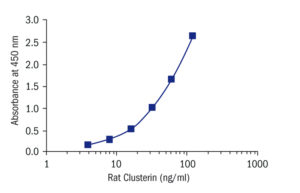Clusterin Rat ELISA
Clusterin (Apolippoprotein J; SP-40,40; TRPM-2; SGP-2; pADHC-9; CLJ; T64; GP III; XIP8) is a highly conserved disulfide-linked secreted heterodimeric glycoprotein of 75-80 kDa but truncated forms targeted to the nucleus have also been identified.
The protein is constitutively secreted by a number of cell types including epithelial and neuronal cells and is a major protein in physiological fluids including plasma, milk, urine, cerebrospinal fluid and semen. Due to its wide breath of tissue distribution many diverse physiological functions have been attributed to Clusterin including sperm maturation, membrane recycling, lipid transportation, tissue remodelling, complement inhibition and cell-cell or cell-substratum interactions. Moreover, it was proposed that Clusterin functions as an extracellular chaperon that stabilizes stressed proteins in a folding-competent state, and that the protein is involved in programmed cell death. Another defining prominent function of Clusterin is its induction in many severe physiological disturbances states including kidney degenerative diseases, prostate and vesicle carcinogenesis, ovarian cancer and several neurodegenerative conditions (Alzheimer’s disease).
Recent study demonstrates, that serum Clusterin level increases significantly in diabetic type II patients and in patients with developing coronary heart disease, or myocardial infarction. These data raise the possibility that elevated Clusterin levels in serum may represent a strong indication of vascular damage.
In patients with systemic lupus erythematosus (SLE), reduced serum Clusterin levels correlated inversely with disease activity. Lowered Clusterin levels could be involved in the pathogeneses of SLE on account of decreased protective effects.
Another interesting observation obtained in rat model suggests that measurement of urinary Clusterin levels may be a useful clinical marker for the severity of renal tubular damage. Furthermore, urinary Clusterin may also help to differentiate between tubular and glomerular forms of proteinuria.
Areas of investigation:
Coronary heart diseases, Myocardial infarction, Neurodegenerative diseases, Kidney degenerative disease, Renal tubular damage
Features
- It is intended for research use only.
- The total assay time is less than 3.5 hours.
- The kit measures Clusterin in rat serum and rat urine.
- Assay format – 96 wells
- Quality Controls are rat serum based. No human sera are used.
- Standard is recombinant protein based.
- Components of the kit are provided ready to use, concentrated or lyophilized.
Research topic
Animal studies, Oncology, Others, Renal disease, Sepsis
Type
Sandwich ELISA, Biotin-labelled antibody
Applications
Serum, Urine
Sample Requirements
5 µl/well
Storage/Expiration
Store the kit at 2–8°C. Under these conditions, the kit is stable until the expiration date (see label on the box).
Calibration Curve

Calibration Range
4–128 ng/ml
Limit of Detection
Limit of detection(LOD) (defined as concentration of analyte giving absorbance higher than mean absorbance of blank* plus three standard deviations of the absorbance of blank: Ablank + 3×SDblank) is 0.7 ng/ml.
Intra-assay (Within-Run)
n = 8; CV = 4.4%
Inter-assay (Run-to-Run)
n = 8; CV = 5.9%
Spiking Recovery
97,40%
Dilutation Linearity
100,10%
Crossreactivity
| bovine | Non-detectable |
|---|---|
| cat | Non-detectable |
| dog | Non-detectable |
| goat | Non-detectable |
| hamster | Non-detectable |
| horse | Non-detectable |
| monkey | Non-detectable |
| mouse | Yes (recommended dilution 1:500) |
| pig | Non-detectable |
| rabbit | Non-detectable |
| rat | Yes |
| sheep | Non-detectable |
| chicken | Not tested |
| human | Non-detectable |
– Adler M, Hoffmann D, Ellinger-Ziegelbauer H, Hewitt P, Matheis K, Mulrane L, Gallagher WM, Callanan JJ, Suter L, Fountoulakis MM, Dekant W, Mally A. Assessment of candidate biomarkers of drug-induced hepatobiliary injury in preclinical toxicity studies. Toxicol Lett. 2010 Jun 16;196 (1):1-11
– Hoffmann D, Adler M, Vaidya VS, Rached E, Mulrane L, Gallagher WM, Callanan JJ, Gautier JC, Matheis K, Staedtler F, Dieterle F, Brandenburg A, Sposny A, Hewitt P, Ellinger-Ziegelbauer H, Bonventre JV, Dekant W, Mally A. Performance of novel kidney biomarkers in preclinical toxicity studies. Toxicol Sci. 2010 Jul;116 (1):8-22
– Sieber M, Hoffmann D, Adler M, Vaidya VS, Clement M, Bonventre JV, Zidek N, Rached E, Amberg A, Callanan JJ, Dekant W, Mally A. Comparative analysis of novel noninvasive renal biomarkers and metabonomic changes in a rat model of gentamicin nephrotoxicity. Toxicol Sci. 2009 Jun;109 (2):336-49
– Vinken P, Starckx S, Barale-Thomas E, Looszova A, Sonee M, Goeminne N, Versmissen L, Buyens K, Lampo A. Tissue Kim-1 and urinary clusterin as early indicators of cisplatin-induced acute kidney injury in rats. Toxicol Pathol. 2012 Oct;40 (7):1049-62
– Zhang F, Sha J, Wood TG, Galindo CL, Garner HR, Burkart MF, Suarez G, Sierra JC, Agar SL, Peterson JW, Chopra AK. Alteration in the activation state of new inflammation-associated targets by phospholipase A(2)-activating protein (PLAA). Cell Signal. 2008 May;20 (5):844-61

